Title: Primordial Black Holes from a tiny bump in the Inflaton potential
Authors: Swagat S. Mishra and Varun Sahni
Authors’ Institution: Inter-University Centre for Astronomy and Astrophysics, Ganeshkhind, Pune, India
Status: Open access on arXiv
We’re still on the hunt for what dark matter actually is. The most popular candidates are usually some sort of particle, like the WIMP or the axion. However, an idea that was first considered by Stephen Hawking (among others), is that tiny black holes which formed right after the Big Bang could also do the trick. There have been many searches carried out for these littl’uns, known as primordial black holes, but there’s been no success just yet. However, whether there’s enough of them floating around to make up some or all of the dark matter or not, we still need to work out how they could have been produced in the first place. For that, we’ll need to go back 13.8 billions years…
Right after the Big Bang, the Universe expanded from a tiny seed by 20 orders of magnitude in approximately one second. That’d be like blowing up a pea to the size of a galaxy in that time. We call this process cosmological inflation. If everything started off really small and close together before being blown up, then we’d expect everything to look pretty homogeneous today even in regions which are really far apart, and that’s exactly the case. For example, the temperature of the Cosmic Microwave Background (CMB) has been measured to be around 3 Kelvin to one part in 100,000 in every direction across extremely large distances. This is why inflation is such a popular idea for how the Universe began.
During the expansion process, any tiny fluctuations that were there initially are able to grow, and it’s these fluctuations that make the Universe not totally smooth and boring everywhere. Once inflation is over, these inhomogeneities can then go on to continue growing and eventually gravitationally collapse to all of the structure, like stars and galaxies, that we see today. That’s exactly what the 1 part in 100,000 fluctuations that we’ve measured are responsible for. If, however, the initial fluctuations happened to be sufficiently larger in some regions, then they’d be able to seed something really dense – like a black hole.
In order to get large enough fluctuations that can collapse to form primordial black holes immediately after inflation, you need inflation to happen in a very specific way. For the Universe to expand rapidly, you need a lot of energy, and we can model how that energy is spent as a ball rolling down a hill losing potential energy. The dynamics of how this ball rolls down the hill describes the dynamics of inflation. The faster the ball rolls, the quicker the potential energy is lost and the less time fluctuations have to grow. This means that if you want really large densities to be able to grow and be left over at the end of inflation, you need to slow down that ball. Today’s authors propose a cosmological speed bump for doing this.
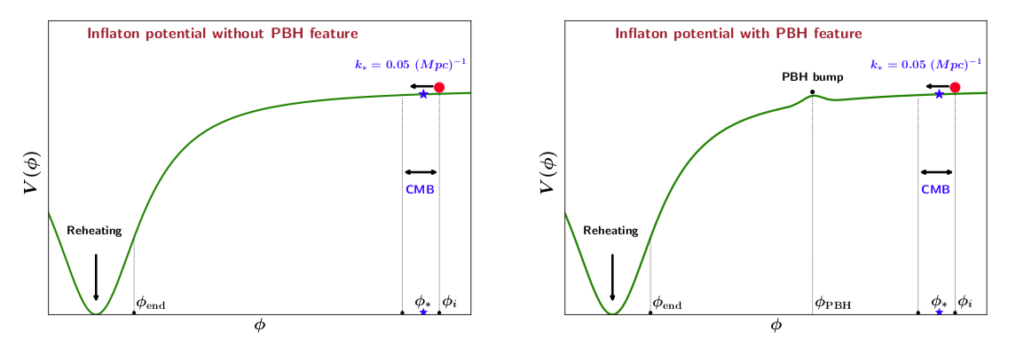
Take a look at figure 1. A regular inflationary model that wouldn’t produce anything dense enough to collapse to form a black hole, just the usual stars and galaxies at much later times, would look something like the left-hand panel. A vanilla model like this is able to fit those measurements of 1 part in 100,000 fluctuations well. However, there’s nothing to stop us producing large overdensities on much smaller scales which we haven’t had the resolution to zoom in on yet with current experiments. A model like the illustration on the right of figure 1 has a little speed bump on the hill, this will slow the ball right down and give the fluctuations time to grow. Once inflation is over, small patches of really high density will be left over that could collapse to form black holes soon after.
Today’s authors calculate the densities left over at the end of inflation for a vanilla model, and for one with a speed bump. It’s a tiny deviation, but it has huge effects on the distribution of densities left over at the end of inflation. This is shown in the primordial power spectrum in figure 2, which quantifies the average density left over at the end of inflation as a function of scale. The left-hand panel again shows the densities left over for a vanilla model, whilst the right-hand panel is for one with a speed bump. Today’s authors’ model is able to fit the CMB data we have, shown by the star, but then for the ‘bump’ model, the densities grow dramatically on smaller scales. The large peak in the right-hand plot demonstrates that the densities left over at the end of inflation on patches of this size were much larger, meaning that black holes will be able to form.
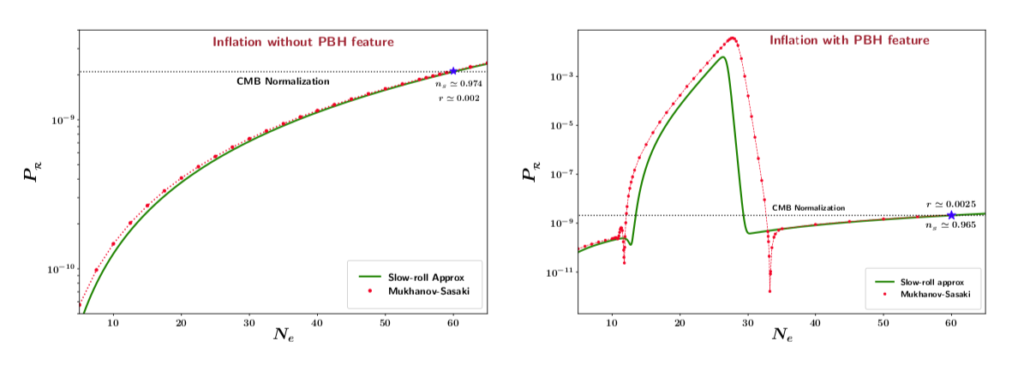
The authors’ speed bump idea can account for everything looking pretty smooth on large scales, as well as producing lots of tiny black holes on smaller scales, which could explain the dark matter mystery. We still need to go out and find one of these black holes, but if we can, not only will we understand more about dark matter, but also how the first second of the Universe went down.
Credit for the (hilarious) title goes to Ciaran Fairhurst at the University of Sussex.

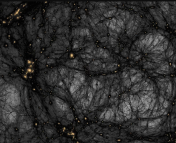
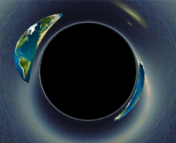
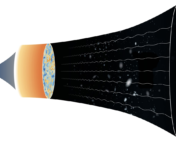

Thanks Philippa for this interesting summary of our paper. This model also obeys your steepest growth bound.